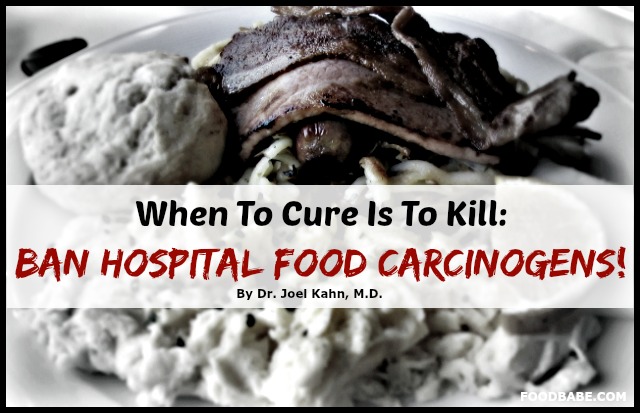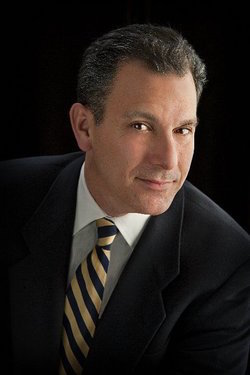This post is written by Dr. Joel Kahn, who serves on my Advisory Council. Dr. Kahn is a practicing interpreventional cardiologist who also writes for Reader’s Digest and has taught dozens of residents and cardiologists. I am thrilled to have him as a contributor here!
If you have visited a hospital lately as a patient, visitor or employee, odds are you have been served foods that would never meet approval with food experts. I am unaware of a hospital system that has joined the movement for foods grown without techniques based on genetically modified organisms (GMOs), or a systematic approach to reduced food chemicals and additives that make many ill. This alone is reprehensible as hospitals should serve as models of health for the community, not laggards. In the American Medical Association Journal of Ethics it was stated that “prevention is a principal focus of most hospitals’ work”…it is logical that hospitals have a stake in providing health-promoting food. Doing so helps a hospital fulfill its mission to prevent disease and promote wellness and health, both by sending a message about proper nutrition and by nourishing patients, students, volunteers, staff, visitors and others. No credible argument can be levied to counter these words but do hospitals live up to them?

What is the responsibility of hospitals if a food group was found to cause serious diseases? Can a food group known to increase the risk of cancer be served in a medical center? Surely when hospitals decided to ban smoking after risk of cancer was established, shouldn’t they be fully committed to tackle cancer prevention in all manners they can? Or is it OK if hospitals are not so committed to cancer prevention if it might hurt the finances, invite criticism from workers and the public, and deny hospital administrators themselves an indulgent even if risky treat?
In my view, hospitals are now facing an ethical choice regarding new statements on the cancer causing potential of a popular food group and they are failing miserably. I cannot remain silent.
What is that choice? I am unaware of a hospital system that has banned processed red meats. I am talking about the appropriateness of serving hot dogs, sausages, bacon, ham, bologna and salami in medical centers. Why the current focus? In 2011 the World Cancer Research Fund (WCRF) reviewed all of the medical reports linking diet and cancer risk and singled out processed red meats as a cancer causing food group. They stated that eating 50 grams a day of these foods showed a “38% increased risk for women and a 64% increased risk for men for colon cancer”. Needless to say, no hospital system I know of took the WCRF report and changed policies to banish processed meats in hospitals. That is to say, hospitals kept serving foods that cause cancer, known as carcinogens, to their patients, guests, and employees. Does this piss you off like it pisses me off? Since 2011, I have shared this data with hospital administrators, I hold staff privileges, and have even posted pictures of bacon and sausage in doctor’s dining rooms on social media as a protest, but my efforts only met deaf ears.
Now we are faced with further data supporting the link between these common foods and cancer.
The World Health Organization, and its International Agency for Research on Cancer (IARC), reported on an analysis of processed meats and cancer and published their findings on October 26, 2015 in a prestigious medical journal for all to read. A panel of 22 experts from 10 countries reviewed the medical literature and concluded that:
“processed meat was classified as carcinogenic to humans (Group 1), based on sufficient evidence in humans that the consumption of processed meat causes colorectal cancer”.
Processed meat was defined as that which had been cured such as hot dogs, ham, sausages, corned beef, bacon and beef jerky. Apparently to cure is to kill.
The IARC panel went on to say that for each 50 grams of processed meat eaten daily, under 2 strips of bacon for example, the risk of colorectal cancer increased by 18%. This statistic is an increase in the relative risk and represents an increase in lifetime risk of colorectal cancer from 5% to 6%. Nonetheless, colorectal cancer is the third most common cancer diagnosed in the United States with over 130,000 new cases each year. Missing in the conversation after the IARC data were released was a discussion of the pain and suffering during therapy for colorectal cancer including disfiguring surgery, chemotherapy, radiation therapy, and the risk of death. Indeed, nearly 50,000 persons die each year in the United States of this cancer. Even a few more deaths yearly directly related to hospitals serving processed meats in view of these strong new declarations by the IARC is a travesty of moral strength and vision by hospital administrators and their medical leadership.
After the IARC data were released I went back to my main hospital administration and asked for a meeting to discuss banning processed meats. I heard nothing and persisted in emails until I heard recently that they turned down a discussion, with the response that “people should have a choice”.
A choice of carcinogens? Lucky Strike or Marlboro? Asbestos or diesel exhaust fumes?
Faced with a stonewall, I have launched a Facebook page “Ban Hospital Food Carcinogens” and have posted articles and pictures to educate the public of the moral breakdown in hospitals and the dangers of eating these foods. However, while what you do in your own home or free time is a personal choice, the food served at hospitals must be held to a higher standard. In the same American Medical Association Journal of ethics it was reported that “it is a hospital’s ethical responsibility to make the health-promoting choice the easy choice” and I agree. They go on to state that,
“just as doctors (derived from the Latin docere, “to teach”) are responsible for teaching individual patients about good eating habits, so are the hospital systems for which they work responsible for promoting dietary change”.
I ask you to join me on Facebook at my protest site “Ban Hospital Food Carcinogens” by hitting Like. I plan on launching a campaign soon to combat these issues and I need your help! The Physicians Committee for Responsible Medicine (www.pcrm.org) has been singling out hospitals selling fast food for years and is planning a renewed campaign to call for a ban on processed meats. With large numbers we can join forces and call for a change long overdue. It is not possible to sit by and be silent while this dangerous hypocrisy continues. Please join me to provide healthier hospital food.
More About Joel Kahn, M.D., FACC, FSCAI

Dr. Kahn is a cardiologist who has launched a campaign to prevent 1 million heart attacks. His brand of cardiology combines the best of Eastern and traditional therapies for total healing. He is known as “America’s Holistic Heart Doc” and graduated Summa cum Laude from the University of Michigan, Ann Arbor. Dr. Kahn has been practicing invasive, interventional and preventive cardiology in Detroit since 1990, and was advanced to full Clinical Professor of Medicine (Cardiology) at Wayne State University School of Medicine and Associate Professor of Medicine at Oakland University Beaumont School of Medicine. He is devoted to his patients who take pride in his passion for teaching and prevention. Reader’s Digest magazine selected Dr. Kahn for their Holistic Heart Doc column and their publishing arm published his book, The Whole Heart Solution, in 2014. His second book, Dead Execs Don’t Get Bonuses, was published in 2015 and both are bestsellers. He appears regularly on Fox TV 2 in Detroit as a health commentator. He has been nominated as a Top Doc in cardiology for most of the past years. In 2013, he received a certification from the University of South Florida in Metabolic Cardiology, and became the first physician to complete the program in the world. To learn more about Dr. Kahn, visitdrjoelkahn.com.








Hospital food is just as bad if not worse than any school lunch menu! Totally vile. But I’m so on board with this post ~ I’ve never given this issue much thought because the only time I’ve spent in the hospital was when I had both babies, and I had my husband bring me food from home. (Sliced veggies, red peppers, cucumbers, fruit, to get me back on feet and hydrated. But this brings me to my second point, something that always shocks me! When visiting patients in the hospital, especially ones that recently had cardiac surgery, it shocks me what relatives bring to their loved ones. It’s like, wow, they bring in tins of cookies, oily processed subs, pizza, taco’s, coffee drinks loaded in sugar and fake chemicals, pies, donuts, and it’s like, hmmmmm, I’m trying not to judge, but is that the right diet for someone who just had heart surgery? Yikes. If you love someone, don’t you bring in food that’s going to aid healing? Even if the person requests those things, I still think you don’t give an alcoholic a drink!
I completely agree the food in hospitals is severely unhealthy. Only time I’ve ever kinda picked at it is when my children were born and it made me feel awful after. I understand they need to feed the masses and they buy lower quality ingredients to do so, but hospitals need to change and practice what they preach. It’s like how they’ll tell you not to smoke and eat well, but you see nurses/doctors lighting up all around building and eating fast food.
America as a whole is completely lazy when it comes to their health and want instant gratification with ease of feeding family. To most spending $30 at a fast food chain is faster/easier then buying groceries and making something for the family. We’ll never change those types of people and that’s their decision to do so, but it’s sad.
As a registered dietitian that only promotes real food I am so glad that I no longer work in a hospital. I would not feel right about promoting the food and diets that they serve. I would be embarrassed. I know that hospitals are ultimately a business but they absolutely no longer practice evidence based health in many forms (not just food).
I’m with ya Sara – I would have quit, or start a protest or something. I couldn’t just sit back and let it happen.
I was hospitalised in 2014 in Austria (Europe) for a dislocated and fractured shoulder sustained while tripping over my suitcase. The food was amazing…tasty and freshly prepared. When I read this article I thought I’d look up the hospital website. As I suspected, high quality food from organic sources, is mentioned as being a priority on the menu. Out of interest, in case anyone understands German, or has a translator app, here is the link to the hospital website.:
http://www.wienerneustadt.lknoe.at/landesklinikum-wiener-neustadt/innerbetriebliche-organisationseinheiten/kueche.html
This is a local provincial (public) hospital. Cost to locals: nothing. Cost to me as a visitor: approximately $1000 (one thousand)US a day FULLY inclusive of all medications, the operation, CAT scans, X-rays and meals. My travel insurance never had it so good! $5000 for the five days I was in there.
Again! Europe does it better! Thanks for sharing, very eye-opening to what is possible!
Thank you for sharing! It’s eye opening!
Unfortunately all over Europe is not like in Austria. I am from Slovenia and food in hospitals is awful. Maybe is a bit better than in USA, but still unhealthy.
Thank you for posting about this. Please don’t forget many other problems with hospital food besides meat. I gave birth at Tampa General Hospital recently, where I was dismayed to learn that they have a McDonalds right in their building. As for the hospital’s room service food, butter is not an option – only margarine is given. (Dr. Weston A. Price’s research is ignored.) If I ask for cranberry juice for a UTI, they only have cranberry juice with high fructose corn syrup, but orange juice does not have HFCS. Very little raw food is offered – basically a banana or a salad. I brought a bag of organic pears and a bag of organic apples with me, thanks be to God, to help me stay regular on the hospital diet and help me wait for the next meal served, which unfortunately is served late on the maternity floor. I knew not to complain about the sucralose or aspartame I saw on a couple of labels because they wouldn’t care, but I was very disappointed that these things are not uncommon and have not changed from when I gave birth in the Midwest 5-10 years ago.
Unfortunately, I’ve had vast hospital stay experience. I’ve had my family bring me homecooked foods or take-out from trusted organic places instead whenever I entered hospitals the past 15 years.
Why is this a shock? Hospitals needs to cut back somewhere.
Is the risk of cancer from meats such as bacon the same if you are purchasing uncured meats that do use nitrates to cure the meat? The bacon I’ve been purchasing uses sea salt, turbinado sugar, and celery powder. Is this as dangerous as eating the nitrate cured stuff?
I was wondering the same thing, so I read the report that was cited above. Processed (cured) red meat was classified as Group 1, meaning sufficient evidence was found that it is carcinogenic. Red meat (which I think would include uncured meat such as the Applegate products you’re referring to as well as things like steak and ground beef) was classified as Group 2A, based on limited evidence that it could possibly be carcinogenic. I’ve also heard that barbequing meat might also be carcinogenic because of the compounds found in the charred portion of the meat, but this article states that there wasn’t enough data to determine this.
I also looked at the risks mentioned in the article and this is what it says about eating the processed version: “An analysis of data from 10 studies estimated that every 50 gram portion of processed meat eaten daily increases the risk of colorectal cancer by about 18%.” The evidence for eating uncured red meat is not as strong, but is estimated to be a 17% risk for every 100 grams daily. The article also mentions that eating meat has known health benefits, so my takeaway from this is to avoid the processed kind but still eat uncured red meat as part of a balanced diet with lots of fresh produce as well as other varied protein sources. The problem here is that hospitals are serving the processed kind, plus they are serving them with sides like french fries instead of a wide variety of fresh fruits and veggies.
I notice they don’t differential between grass fed red meat and grain fed red meat…. Which you know it’s the latter. Big difference!
I visited a friend in the hospital who had just had cancer surgery.
I arrived when she was just having her first meal – ugh! It was a hamburger on a white bread bun. There were also little packages of crackers – I looked at the ingredients – the chemical feast. Also non dairy creamer for the coffee. I was so shocked they would serve this garbage to sick people!
I think hospitals serve that crap to help insure they have future customers. Making people healthy is bad for business. The food they serve is cheap and it makes people sick. That’s a win win for the hospitals. It’s all about the money so I think you’re going to have a long battle ahead to try and fix this. Unfortunately there’s no real way to boycott this so I will be amazed if they ever actually change their ways. Money trumps all in America. Good luck with this fight. I hope it works but I’m doubtful.
Some, if not all, hospital food is like restaurant food. It is like school lunch food they serve your kids. Almost nothing on it is fresh.
And why don’t they serve certified RAW MILK and RAW BUTTER?? It is said the Mayo Clinic use to use this to HEAL patients at one time!
My husband entered the hospital through the emergency room. I was “comforted” by a nurse who said the meals they served were “fantastic” and everyone loved them. When I saw the first menu offerings, I was sick: pizza, hamburgers, hot dogs, iceberg lettuce salad, corn, hash brown potatoes, potato salad, mac n cheese, skim milk, apple juice, coffee, tea etc. I went to the cafeteria to see if I could get something better for him, hoping for a salad bar. It was worse, grilled cheese, brats, baked beans, macaroni salad, iceberg lettuce in plastic bowls and a few strings of carrot on top. There was a “special of the day”, with some kind of patty swimming in gravy, mashed potatoes and overcooked green beans. The wait staff shrugged his shoulders when I said that nothing looked healthy. I walked out and went to Chipotles to get supper for my husband. Thankfully, he was there only overnight so that ended the horror of hospital food. Next time, we’ll be prepared.
So you decided to serve him e-coli instead? Nice!
Huh? Where do you see she served him E coli?
There was an E coli outbreak over the summer. Apparently, over 100 people were sick and it was linked to Chipotle. Hence, the E coli comment. There are numerous lawsuits pending against the company. Still, I would have chosen Chipotle over that other death on a plate…probably.
The University of Vermont Medical Center has an outstanding hospital menu, take a look at: www,UVMHealth.org/MedCenterSocialMedia
Our Grand Island Nebraska hospital serves such bad food, you can smell the msg as you enter the hospital. It is disgusting and nauseating. When I was in an Omaha, Nebraska hospital last year for a little over a day, I could not eat anything but some soda crackers. Though they weren’t organic, they were safer to eat than any thing else they had because of the msg they contained.
I recently was released from a short hospital stay in the treatment of a severe case of diverticulitis. Once I was put on soft foods I was shocked at the kinds of foods they brought me which clearly labeled high fructose corn syrup in their list of ingredients for various juices. Many of the desserts had come from outside commercial groups which are also using artificial dyes sweeteners and again more high fructose corn syrup.
I was set back that a hospital would be giving me and other patients such toxins as these in the food they serve.. Even the dressings for their garden salad again listed more ingredients from pesticide laced GMO’s including a non food item frequently used: cottonseed oil.
Knowing that the body does not digest high fructose corn syrup and that it is filtered from the body through our blood by the liver much like alcohol, with similar toxic effects to this important organ. How then, with all these known medical facts and the disease they cause could any hospital allow these ingredients to be fed to myself and other patients? That was my question during my stay and now, less than seven days after my release I am reading this article. No coincidence. I am relieved to see Vani and others taking on this important quest to wake up another industry and see through with the elimination of these products from hospital menus. Thank you Food Babe.
My father was hospitalized for a major stroke that he had in 2014. Unfortunately
he was put on a feeding tube and I was completely appalled and disgusted at the ingredients, especially him being a diabetic. It was mostly all sugar and chemicals! My sister is the holistic RN in the family(thankfully) and she found a company that has all organic ingredients, it’s called “Liquid Hope” http://functionalformularies.com/products/liquid-hope. Not one Nurse or Doctor in 3 hospitals had ever heard of it (Shocker)! We had to get approval to bring it in the hospital, which we did. If you have a loved one in the hospital that needs tube feeding, there is a better choice available so please be aware. Most importantly INSIST on it!!
See my comment below. We got Liquid Hope, and also foods from Real Food Blends. Both excellent. And my husband’s condition reflects the difference! He’s doing very, very well, unlike everyone else in that place.
I am a former Pediatric Hospitalist and a current General Pediatrician in Charlotte, NC. I have an integrative approach to medicine and strongly believe in nutrition as one of the main causes of disease. Unfortunately, despite my efforts, advice, and blog posts, some of my teenage patients already have metabolic syndrome (high blood pressure, diabetes, and heart disease). Occasionally, they have to be hospitalized for education and further medical evaluations and treatments. During these hospitalizations, my patients and I are utterly confused and at a total loss when it comes to the diet served in the hospital where I have to send them to begin the process of healing. I have brought this up to administration many times to no avail. I am excited about the possibility for change. Thank you for embarking on this critical mission for change. Best Regards, Ana-Maria
I don’t think a place that is mostly interested in “cutting and poisoning” people is going to care about the food that is served to their patients. Although, I truly do appreciate the concern from Dr. Kahn about the hospital food and very much understand it, as I used to work in the dietary department of a hospital. Five years after I quit there, I read the book PATIENT HEAL THYSELF by Jordan Rubin. It opened my eyes to the fact that a lot of us are killing ourselves with our food choices and that we could actually heal ourselves with the proper nutrition. I now work in a health food store. I have thought back to when I worked in dietary and am disgusted by the foods that were served to the patients. No healing going on there! So it will take quite awhile, but the world is slowly learning about healthier food and changing. I appreciate that FoodBabe and others are helping to do just that! 🙂
Diabetes is such a terrible ailment and what disappoints me to no end is MY MOTHERS NUTRITIONIST TELLS HER IT IS JUST FINE TO EAT THOSE HORRIBLE POPSICLES FULL OF DIFFERENT TYPES OF SUGARS/SWEETENERS…along with the colors and other crap!!! What is wrong with the health industry…….. hugs to you vani and the team.
Vani, I survived a ruptured brain aneurysm in September, 2014. After being sent home from Urgent Care with a diagnosis of “dehydration,” I Went to a hospital 12 hours later to be told that my brain had bled, then to undergo emergency brain surgery. Imagine my horror when, in recovery, the first meal they offered me was beef brisket, scalloped potatoes and apple pie! I was mortified. I tried to remain calm, while I politely refused that poison and expressed how appalled I was…that they would even consider offering me this, after my head had been cut open. What my body needed was pure green juice, but this leading hospital did not offer anything like that. With persistence, I found I could get a salad instead. For the duration of my fifteen day stay, my sweet husband brought me veggie juice from home. I am reading your book and already have supported many of your petitions. This one really strikes a chord with me! Hospital administrators need to feed patients what their bodies need, and stop making decisions based on patient survey feedback! Let’s shed some light into the minds of the medical experts: food could likely be the original cause of the conditions that put patients in the hospital to begin with! So, I’m completely on board with this one! Let’s fix this major, gaping hole in our sick-care system!!
Thanks and gratitude to Vani for allowing me to work with her to highlight a huge hypocrisy in the medical system, food that harms while we work so hard to heal. Surgery, chemo, lasers, stem cells, radiation, drugs…..no end to technology that cost billions and trillions, and often represents true breakthroughs, but prevent? Heal? Use nutrition to promote return to health? Protect the employees from the ravages for food borne disease that fill ERs and hospitals? NO ZERO interest in general. Rare exceptions. So lets start a tidal wave, a tsunami, an earthquake, a volcano of protest, demanding safe food in the very place it should be first, healing centers.
Joel Kahn MD http://www.drjoelkahn.com
Hospital food is bad and unhealthy. Nursing Home food is really bad also. Unless they have changed since I visited one several years ago. The food in the nursing homes have no flavor. When I had chemo in the hospital here, they served me soft drinks,sweet deserts, hamburgers cookies, crackers and anything I might ask for but I ordered vegetables and fruits when they were available. At that time I had not started eating healthy and did not know that food had much to do with my health unless over eating or maybe too many sweets. Some hospitals even have snack bars that sell nothing but junk food.
Dr. Khan,
Thank you for your post.
You make a good point, it does not make sense to serve these types of processed foods in hospitals (and schools).
I would also include:
* foods rich in refined sugar- especially considering the links between sugar and inflammation.
* artificial dyes/sweeteners should at least not be served to children.
Best,
Amina
(to Robert)
I Agree 100%
Thank you food babe for your work! I agree the food in hospitals need to change! Serving foods that actually make people sicker is unethical!
Man, you are just getting started! Suppose you have a stomach tube. There is one flavor on the menu. It contains high fructose corn syrup (GMO), soy protein (GMO, loaded with estrogen), maltodextrin (destroys intestinal flora), canola oil (GMO), and a token assortment of vitamins with quantities well under the RDA. And they expect people to get better on this trash! You really, really need to go on a campaign against this. We were able to stop this “food”, sort of (though a doctor ordered it behind my back), but think of all the people in the hospital who have no idea, and wouldn’t know how to put a stop to it if they wanted to. I call this “Belly Bullying”.
Actually many hospitals endorse blended diets for feeding tubes. Picture running what you had for dinner through a vitamix or blendtec blender. It works!
And many hospitals do not. I didn’t run into any that did, and there were three hospitals involved. They need to offer to blend the food as well. Most people don’t have the equipment to produce food thin enough to go through the tube. And most people’s diets are pretty atrocious and also should not be fed to anyone, let alone a sick person.
Another term for what most hospitals do is “Tummy Tyranny”.
After a mastectomy, the first thing fed to my Mom in the hospital was Jello. Sugar feeds cancer cells (not to mention the carcinogenic glyphosate it’s laden with etc.). It’s insanity.
Now this is subject matter that is very near and dear to me as I spend a lot of time in hospital because of someone in my life with chronic illness and also work in patient advocacy. Vani I’m no troll, I’m no shill, I’m an honest human being and can say that your plan lacks feasibility and insight into the lives of those who often consider the hospital a second home. You’re looking at families whose lives have been halted financially because of illness and often on a single income. Sure there are many hospitals that would get a failing grade and could at least try to be somewhat healthy. I myself am lucky to be attached to one that limits its connections with soda companies, has fresh veg and fruit options, beautiful salads and whatnot. But what I am stating is that you are missing a huge chunk of the big picture here in terms of the huge expense that would be involved in making such a change. You would have a lot of the families who already are financially overwhelmed, incredibly worried.
I don’t want to sound rude but go to the grocery and price check processed junk and real foods like vegetables, most times the junk is more expensive. Not to mention if your financially strained wouldn’t you want to do all you can to aid medical help rather than make whatever condition you have worse ? It saves money in every way….
This is great information, but Dr Kahn didn’t mention what it is that we need to avoid when we are looking at purchasing meat products for personal consumption. Are there any “good” bacon or ham offerings available or is he suggesting that we don’t eat any of these products at all???
Why, even after the WHO declared that processed meats are linked to cancer?? I seriously believe that there has to be action taken against this!
Thank you for this article.
I was just AGHAST at the food my state’s premier CHILDREN’S HOSPITAL was serving when our one and a half year old had to go in for emergency surgery.
We are VERY careful with what our family eats. When we ordered the fish for her I thought surely it would be better than the icky child standbys of burgers, pizza and hot dogs. When we received processed FISH NUGGETS in FISH SHAPES my husband ran home for home-made meals for our child for the rest of her stay.
Seriously? This “food” is not helpful to anyone trying to get better after illness or surgery.
I saw this article on the NPR site today about hospitals wanting to switch to meats raised without antibiotics. Is it for real or more lip service ??
http://www.npr.org/sections/thesalt/2016/01/12/462176257/more-hospitals-are-ditching-antibiotics-in-the-meat-they-serve
I had to stay overnight after a procedure and I clearly stated that I don’t eat grains or sugar. I was surprised when my breakfast tray arrived containing Cheerios, a roll, orange juice and coffee. I kept the coffee and requested an egg. Luckily that was my only meal.
Can we please address ensure and other meal replacement products ?!?! They not only offer/push/suggest these in hospitals but nursing homes doctors offices and for children who are “picky” eaters !! These are poison!
It truly is all about money, so sad! When did helping people stop being the goal?!
Well considering the medical profession exists solely to profit off of illness it only makes sense that they would serve poison in hospitals. Noble idea. Never gonna happen though.
Hospital food = Oxymoron!! There is no such thing as food in hospitals….it’s nothing more than ersatz “food” such as we find in most markets and fast-“food” joints in America! Instead of feeding immune-compromised people real foods that help build up the immune system, they are washed with just more of the poisoned crap that put them there in the first place, (not to mention the sleep-deprivation)! It’s also about time the hospitals stopped counting the bottom line when it comes to providing real food and real medicine (ex. Vitamin C) to help their sick get better and start firing their “dietitians”, “nutritionists” and most especially all the dead wood administrators at the top – even many of the doctors – who run these dens of death, collecting – no diverting! – VAST sums of money in compensation while their patients needlessly exit the earth!!! In 2016, with all the information out there today such as Vani Hari, Dr. Mercola, Natural News, Millions Against Monsanto, The Truth About Cancer, Suzanne Somers, fermented foods, Life Extension Foundation, and many too numerous to mention, there is ABSOLUTELY NO EXCUSE for those who run the hospital system to NOT know what constitutes real food! They know full well that it is the key to healing people unless their brains – and especially their consciences – are totally dead!! The racket has to stop!!!
Also too, when the umbilical cord between the hospitals/doctors and Big Pharma is cut once and for all can we see hope for the system and ultimately the patient!!
Vani,
I’d like to reach you somehow regarding the Nestel link you had on FB . I asked if they might consider GMO labeling and was harassed for over 10 hours until I figured out how to block the company . Are they allowed to do that ? They called you and me names for hours .
I would really appreciate a response back to this, maybe through private email